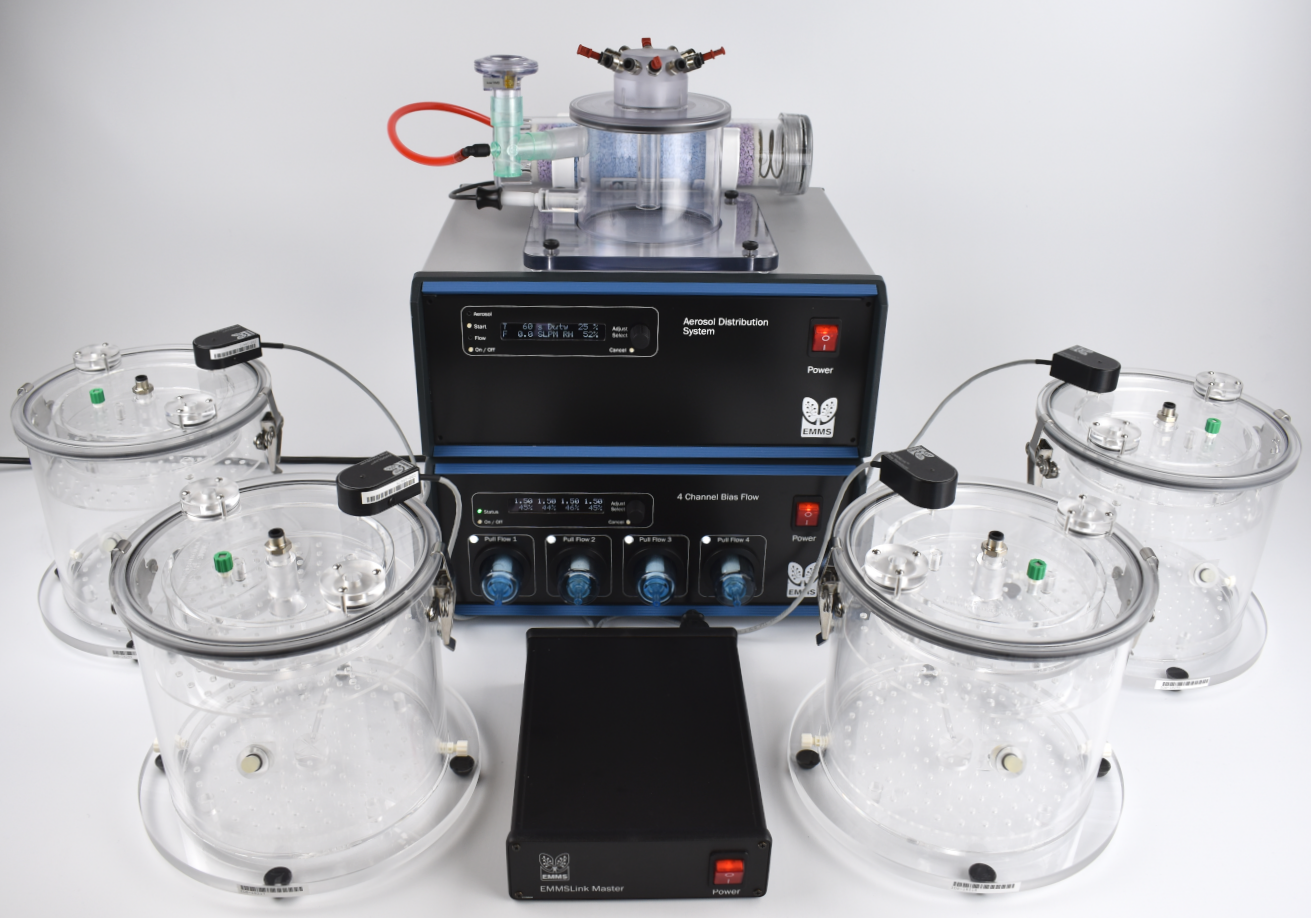Description
The EMMS Whole Body Plethysmography (WBP) solution is a system where the animals are freely moving inside of the chamber during the experiments. The system is designed to provide accurate measurements and is fully compatible with EMMSlink technology that provides automated calibration, and all the electronic components are daisy chained for reduced number of cables in the setup.

Advantages
Automated Calibration
Low noise design
Chambers available in acrylic and optionally they can be produced in polycarbonate.
System is compatible with EMMSLink, so all the electronic components can be daisy chained for a reduced number of cables and more organize system.
Aerosol delivery with active humidity control.
Complies with 21 CFR Part 11.
Applications
Whole Body Plethysmography is a very versatile system that can be used for different applications, such as Safety Pharmacology, Apnea, Asthma, Cough and Hypoxia.
There are different software analysers available for this type of system, and different parameters are available for each. The following lists are not exhaustive and show some of the parameters available:
| Name | Units | Description |
|---|---|---|
| TV | ml | Tidal Volume, volume inspired during one breath |
| tI | s | Inspiration time |
| tE | s | Expiration time |
| PIf | mls/s | Peak inspiratory flow |
| PEf | mls/s | Peak expiratory flow |
| f | breaths/minute | Frequency of breathing |
| MV | ml | Minute Volume, volume inspired in one minute |
| tR | s | Relaxation time |
| TB | % | Duration of breaking. Percentage of the breath occupied by transitioning from inspiration to expiration |
| TP | % | Duration of pause before inspiration. Percentage of the breath occupied by transition from expiration to inspiration |
| AV | ml | Accumulated volume |
| EIP | s | End inspiratory pause |
| EEP | s | End expiratory pause |
| Penh | (NONE) | Pause enhanced, index of constriction |
| VolBal | % | Difference between inspiratory/expiratory volume |
| Atm | mbar | Atmospheric pressure |
| Hum | % | Relative humidity in chamber |
| Temp | deg. C | Air temperature in chamber |
| BTemp | deg. C | Body temperature of animal |
| Corr | N/A | Drorbaugh & Fenn volume correction constant |
| NTemp | deg. C | Nasal temperature |
| AtoB | N/A | Epstein & Epstein A/B ratio |
| Name | Units | Description |
|---|---|---|
| NSigh | count | Number of sigh detected |
| PSigh | % | Percentage of time spent in sigh |
| PSniff | % | Percentage of time spent sniffing |
| NApnea | count | Total number of apneas (any type) |
| PApnea | % | Percentage of time spent in apnea (any type) |
| TApnea | s | Average duration of apneas |
| N0Apnea | count | Total number of Type 0 Apneas |
| P0Apnea | % | Percentage of time in Apnea Type 0 |
| N1Apnea | count | Total number of Type 1 Apneas |
| P1Apnea | % | Percentage of time in Apnea Type 1 |
| N2Apnea | count | Total number of Type 2 Apneas |
| P2Apnea | % | Percentage of time in Apnea Type 2 |
| Pnormal | % | Percentage of time spent breathing regularly |
| Name | Units | Description |
|---|---|---|
| VCO2 | lmin-1 | Rate of CO2 production |
| VO2 | lmin-1 | Rate of O2 uptake |
| MR | kcalmin-1 | Rate of O2 metabolism |
| RQ | n/a | Respiratory quotient |
| CO2Ref | % | Reference CO2 concentration |
| O2Ref | % | Reference O2 concentration |
| CO2 | % | Current CO2 concentration |
| O2 | % | Current O2 concentration |
Specifications
The table below shows the standard chamber sizes for small animals. For other customized sizes, please contact us:
| References | Species | Size Guidance |
|---|---|---|
| PLY 310 | Mouse | 5 to 30 g |
| PLY 320 | Hamster, Rat | 100 to 400g |
| PLY 330 | Guinea Pig | Up to 1000 g |
| PLY 331M | Marmoset | Up to 1500 g |
| PLY 340 | Rabbit | Up to 2000 g |
Images
References
Exclusive expression of MeCP2 in the nervous system distinguishes between brain and peripheral Rett syndrome-like phenotypes
Paul D. Ross, Jacky Guy, Jim Selfridge, Bushra Kamal, Noha Bahey,K. Elizabeth Tanner, Thomas H. Gillingwater, Ross A. Jones, Christopher M. Loughrey, Charlotte S. McCarroll, Mark E.S. Bailey, Adrian Bird, and Stuart Cobb
Defined neuronal populations drive fatal phenotype in a mouse model of Leigh syndrome
Irene Bolea, Alejandro Gella, Elisenda Sanz, Patricia Prada-Dacasa, Fabien Menardy, Angela M Bard, Pablo Machuca-Marquez, Abel Eraso-Pichot, Guillem Modol-Caballero, Xavier Navarro, Franck Kalume, Albert Quintana
Causal relationship between humidifier disinfectant exposure and Th17-mediated airway inflammation and hyperresponsiveness
Mi-Kyung Song, Dong Im Kim, Kyuhong Lee









